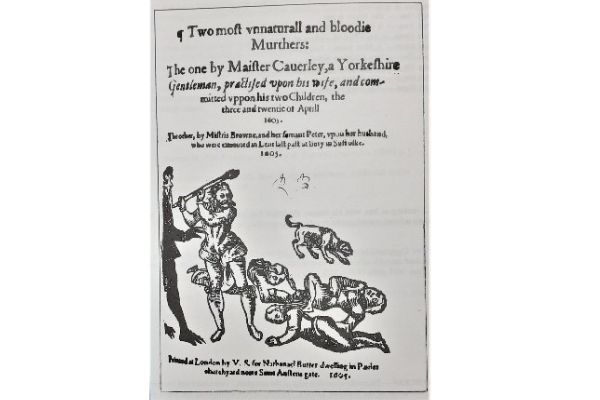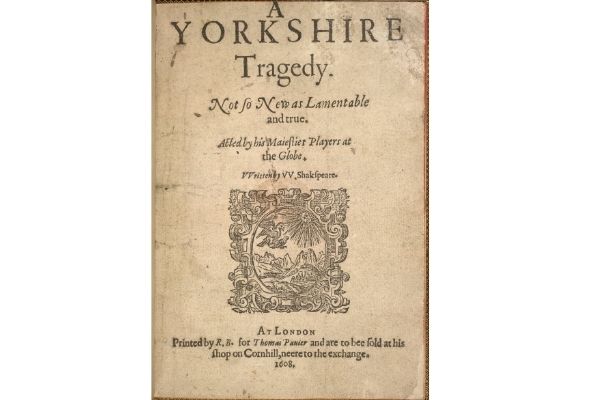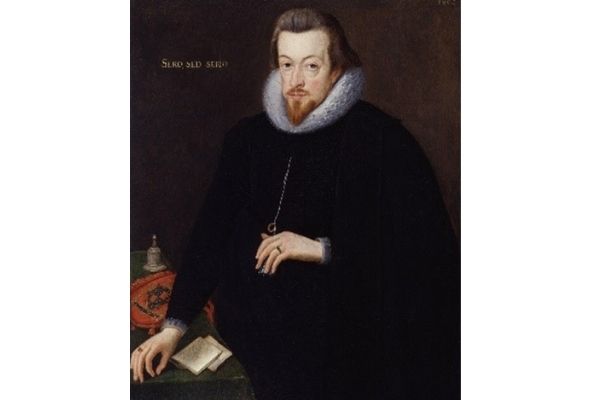An ‘Unnaturall and bloodie Murther’: New Thoughts on Calverley’s Yorkshire Tragedy
On 23rd April 1605, a tragic event took place at Calverley Old Hall in the village of Calverley just south of Leeds that has fascinated historians and local residents ever since. Walter Calverley, young master of an ancient household and deep in debt, brutally stabbed and murdered his two tiny sons, and attempted the same on his wife Philippa, her life saved only by the boning in her corset. He threw a nursemaid down the stairs, before ordering a servant to fetch his youngest baby son from the wet nurse twelve miles away to meet the same fate. When the servant did not obey, Walter set off himself by horse to kill the babe (or perhaps merely to flee). His horse stumbled, and he was arrested by pursuers under Sir John Savile, a local worthy and a long-time associate of the Calverley family. The ancient family's disgrace and humiliation could not have been greater.

The cover of the 1605 pamphlet shows Walter Calverley in the act of murdering his young sons, egged on by the Devil.
Why did Walter disintegrate that fateful April night, and what caused acts of such desperation? The accounts that have come down to us simply place all blame on the murderer, but there is a circling cast of other characters around the dreadful event. I am increasingly convinced that there is more to be said about the background to the Calverley murders. After his arrest, Walter refused to plead, so placing himself outside the normal legal system of trial by jury and condemning himself to execution by ‘pressing’, the victim dying by being literally pressed to death beneath heavy stones. Under the custom of the day, in refusing to plead and choosing such a death, Walter avoided forfeiting his land and property to the Crown as a convicted criminal. This meant that when he was thus executed on 5th August 1605, his surviving baby son Henry was able to inherit the family estate when he came of age in 1623. Walter’s wife Philippa lived to remarry, and died of natural causes in 1613.
There is much local legend about the affair but few contemporary sources.
Three literary sources survive, all published in London, and all of unknown or uncertain authorship. The first of these is a pamphlet called Two most unnaturall and bloodie Murthers: the one by Maister Calverley, a Yorkshire Gentleman…’ (1605). Its author is unknown.
The second source is an intense one-act play called A Yorkshire Tragedy. While the play’s main action is explicitly set in Yorkshire, its characters are simply named by role: ‘Husband’, ‘Wife’, ‘Servant’ etc, and Calverley as a place is not mentioned directly. However, it clearly took its inspiration from the pamphlet, which it follows closely in narrative and sometimes phrasing. The Husband has gambled and drunk away his inheritance and believes his Wife is unfaithful to him. In desperation at his debts, he murders his sons to prevent them facing the shame of pennilessness.

The frontispiece of the play A Yorkshire Tragedy incorrectly bears Shakespeare’s name, a marketing ploy by the publisher.
This play was probably first acted in 1605 but was not published until 1608, when Shakespeare’s name appeared on its title page, and this was repeated in future folio editions. However, the standard of writing makes this attribution hardly credible, and modern scholarship has proved that it was written by playwright Thomas Middleton. If Shakespeare was involved at all, it was only in adding a line or two in rehearsal, as often happened.
The third source is another play, The Miseries of Enforced Marriage, by George Wilkins. This was published in 1607, the year before publication of A Yorkshire Tragedy (though both would have been performed before publication). Miseries is as a much a farce of manners as a tragedy, a looser retelling of the tale that guys the failings of Jacobean society. It too is interesting, because it potentially adds additional, thinly disguised detail of the wider circle of people involved – disreputable friends milking the young man, scenes in London as well as Yorkshire, a jilted former fiancée who also appears in the actual historic record. It also replaces murder with reconciliation to end the play.
Turning to more factual evidence, two centuries later, Walter’s examination after his arrest by Sir John Savile was also published, based on a lost original document (see T D Whitaker, Loidis and Elmete, 1816). This is the closest we get to Walter’s version of events, and it makes bleak reading. In his own account, even in the depths of self-evident guilt, Walter appears surprisingly unrepentant. He claims he had been driven to murder by his wife’s taunts that he was not the father of their sons and that he had been harbouring murderous thoughts towards his sons for the past two years, as well as believing his life to be under threat from his wife. Walter may of course have been deluded, but there is no doubt that this was how he saw his marriage, and had done for at least two years.
However, in the pamphlet and both plays, the wife is presented as blameless, meek and supportive of her unreasonable wastrel of a husband. The question of the boys’ legitimacy and her own taunts and threats as raised by Walter in his deposition are absent from both the pamphlet and A Yorkshire Tragedy, though they are central in Miseries. The official, factual record of Walter’s examination transcribed in 1816 was buried in the York court records in the early 17th century and was apparently not available to the London authors at the time they wrote the pamphlet and plays, since none refer to it. Nor do any of them include reference to Walter’s gruesome death, a retribution that would surely have been appreciated by the blood thirsty audiences of the Jacobean theatre.
In 1991, local Calverley historian Edward Garnett meticulously assembled some wider factual evidence in his pamphlet The Calverley Murders. This included highly significant family letters from Walter’s mother-in-law, Lady Anne Cobham, to her brother-in-law Robert Cecil, also Elizabeth I’s Lord Privy Seal and one of the most powerful men in the land. However, Garnett did not investigate the wider context and stuck to the received interpretation that Walter was a profligate and unstable young man, who brought about his young family’s ruination through his extravagant habits, ‘a man incapable of living up to the standard of his wife’s relations and to the age-old standards of his famous Yorkshire family.’
 Robert Cecil, Elizabeth I’s Lord High Treasurer, in 1602. (John de Critz the Elder)
Robert Cecil, Elizabeth I’s Lord High Treasurer, in 1602. (John de Critz the Elder)
Yet I think there may be more to be said. That Walter was guilty of the appalling and inexcusable crime and suffered a terrible breakdown is not in dispute. His father too had been subject to fits of ‘dangerous melancolicke lunacie’ (though not of a murderous kind). A case can be made for a different interpretation of the events leading up to the murder, based on the historical as well as literary sources. The plays and pamphlet evoke an intimate sense of the immediate household on the night of the murders, but the factual sources hint at possible different motivations and provocations.
Close reading of these sources suggest that Walter’s wife and her family may not have been benign participants in the events leading up to the crisis; that Philippa may have been an unfaithful wife, and that her mother Lady Cobham and other relations were scheming to take control of the Calverley estates from Walter. They may have done so with the connivance of the highest in the land, the Brookes of Cobham Hall and even involving Robert Cecil. Cecil was Queen Elizabeth’s Secretary of State at the start of these events, a position he maintained under her successor, James I &VI, who came to the throne in 1603, two years before the murders.
Philippa and Walter were married after a whirlwind courtship in 1599, when both were still minors and so wards of court. (In those days, the Crown claimed the right to the estates of all who inherited as underage minors, and then of approving their marriages. Ostensibly for the protection of the young heirs, this was in fact a way of managing the power of the aristocracy and a valuable source of Crown patronage. It was a deeply unpopular policy by the early 17th century.)
Walter was a desirable catch for a young woman from a cadet branch of a powerful family like the Brookes. Old Queen Elizabeth was in her twilight days, still refusing to name an heir: Cecil was already being careful to nurture secret relations with Elizabeth’s closest blood relative, James VI of Scotland.
And Yorkshire was an important region for any English monarch to keep onside. The Calverley seat was a significant one in the county, and Walter was great-grandson of a former High Sheriff. He could be expected to tread a similar path: in other words, he was a pawn who could be useful in high places.
Soon after Walter came of age in 1601, we find Brooke placemen taking the Calverley estate into trust for the young couple, followed by a string of land sales from the estate. This was presumably to alleviate Walter’s debt, or perhaps because his competence was in doubt. There is no evidence of the religious fervour of the previous generations of Calverleys so his debts do seem to be because of extravagance rather than through fines for Catholicism.
A key figure in all accounts is Walter’s mysterious ‘guardian.’ Wardships were typically handed out to noble families, but there is no one in the historic record who plays this role for Walter at the time of his marriage, other than the Master of the Ward of Courts at the top of the chain – who was none other than Robert Cecil. Philippa too had an anonymous ‘guardian’ in the story, sometimes described as her uncle. By his marriage to Philippa’s aunt, Elizabeth Brooke, Cecil was also her uncle.
According to the pamphlet, the trigger for the events of the fateful night of the murder was Philippa’s return to Calverley from visiting her unknown guardian with an offer of a place at Court, rather than the hard cash Walter had despatched her to obtain. It is possible that this powerful figure of the shadowy guardian was none other than Robert Cecil himself? If so, this places Calverley Old Hall at the centre of a tale of murky political manoeuvring from the centre of power.
At Philippa’s news, weighed down by debt through his own extravagant habits, emasculated in his own Yorkshire affairs by his worldly in-laws and burdened with a sense of personal inadequacy that prevented him taking up the offer of place at Court, Walter, already mentally unstable, was pushed over the edge into enacting his terrible deeds.
According to this interpretation of the events, the pamphlet and plays that have come down to us could be seen as skilful reworkings of the actual events to whitewash the role of the Brookes and perhaps of even of Robert Cecil himself in order to protect the image and role of Philippa and the extended Brooke/Cobham families from this tragic scandal.
Literary scholars pore over the text of A Yorkshire Tragedy as an unusually bleak example of Jacobean tragedy, and for the mystery of its author. For the residents of Calverley and for supporters of Landmark as we restore Walter Calverley’s ancient manor house, there is keener interest in better understanding the actual historical events behind the murders, and their motivation. We may never know the entire truth of the affair - there have been so many changes to the building over the years that it is not even clear exactly where the murders took place. However, it seems sure that more insights will emerge about the tragic story of Walter and Philippa Calverley as our restoration project unfolds.
Our Calverley Old Hall appeal